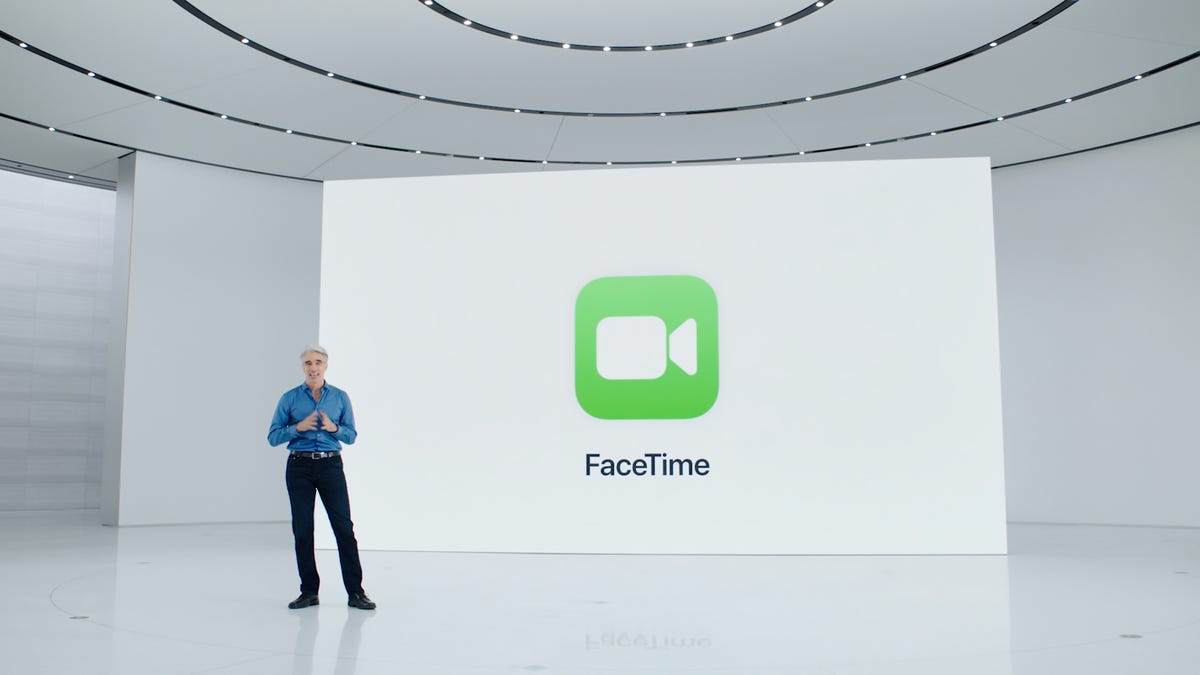FaceTime's iOS 15 upgrades: Blur backgrounds and schedule calls, just like in Zoom
FaceTime will work on Android and Windows, among other new features.

Craig Federighi, Apple's head of software, talks up FaceTime updates during Apple's WWDC keynote.
Apple's FaceTime will soon look a lot more like Zoom and Microsoft Teams. The iPhone maker on Monday said it's adding features to its videoconferencing software that will let people schedule calls and even access them via a browser on Google Android and Microsoft Windows devices. The announcement came at Apple's WWDC 2021 keynote.
"You can generate a link for a FaceTime call and share it anywhere," Craig Federighi, Apple's head of software, said during the company's Worldwide Developers Conference keynote address. "It's a terrific way to plan ahead for a call." (Here's how to join FaceTime calls on Android and Windows devices.)
Apple also built new features to improve audio in FaceTime. The addition of spatial audio in FaceTime is supposed to make it sound like the people you're talking to are in the same room, and voice isolation on the microphone will dampen ambient noise and prioritize the speakers' voices.
The aim was to make FaceTime "more natural, comfortable and lifelike," Federighi said.
Portrait Mode in FaceTime will blur the background and keep the people in focus.
And SharePlay lets you watch TV shows, TikTok videos and other media with friends over FaceTime. Initial partners include Disney Plus, ESPN Plus, Hulu, HBO Max, MasterClass, NBA, Paramount Plus, Pluto TV, TikTok and Twitch. A new API will let developers make their apps compatible with SharePlay. Everyone on a SharePlay session has to have a subscription to the service for it to work. And the content has to be downloaded locally onto your device, not streamed over the internet.
Adding new features to FaceTime makes Apple's software better able to compete with Zoom, Teams, Google Hangouts and the various other video calling services out there. As the pandemic has forced millions of people around the globe to work from home for over a year, and kept families and friends apart, videoconferencing has become a vital tool to help people stay connected and get work done. Opening FaceTime to Android and Window users -- albeit via the web, not dedicated apps -- reflects a realization by Apple that to reach more users it needs to expand beyond iPhone, iPad and Mac owners.
See also
"The ability for Apple owners to invite Android and PC customers to FaceTime calls via a browser is an acknowledgement that the pandemic has sparked explosive growth in group video calling," noted Ben Wood, chief analyst at CCS Insight. "Apple risked being left behind services such as Teams and Zoom; however, browser-based access may not be enough to drive significant adoption. Apple has clearly decided to balance the need for greater competitiveness with its own ecosystem motivations."
Even though Apple will let Android and Windows users join FaceTime calls, they can't set them up. That requires having an Apple device and Apple account. Android and Windows users accessing a FaceTime call through a browser don't have to have an Apple account, but they can't enter the call until the person who set up the call approves them.
The FaceTime news came as part of Apple's introduction of iOS 15, its new iPhone software. The next release of iOS is one of the most important announcements at WWDC. The company's iPhones are among the most popular smartphones in the world, and it makes iOS updates available to people who own older phones. That means a significant percentage of people in the world likely will use iOS 15 within the next year. Most iPhone owners typically download the latest software within weeks or a few months of its release, helped by the prompts Apple sends them. As of June 3, 90% of all phones introduced within the last four years use iOS 14, the software introduced last fall.
Apple unveiled the new software Monday during a virtual WWDC, its second in a row. Typically, the company gathers thousands of developers in Northern California to show them its newest software and services that will arrive on devices later in the year, but the COVID-19 pandemic has moved tech events online. The company may be best known for its hardware, but the seamless integration of its hardware with its software is what sets Apple apart from rivals. Apple also has been expanding its services with Apple TV Plus, Apple Fitness Plus, Apple Card, Maps and various other offerings.
Apple's ability to control every aspect of its products has been key to making it the most powerful company in tech. But that power has invited scrutiny. Apple and Fortnite game developer Epic last month wrapped up a trial over App Store policies, and a district court judge will now decide if Apple's policies and the 30% commission it takes on purchases inside apps are illegal. At the same time, regulators around the world and in the US are weighing whether Big Tech companies -- including Apple, Google, Facebook and Amazon -- have become too big and powerful. And an App Tracking Transparency privacy update in iOS 14.5, which requires apps to ask permission to track users for ads, has angered Facebook and other developers who make their money from advertising.

